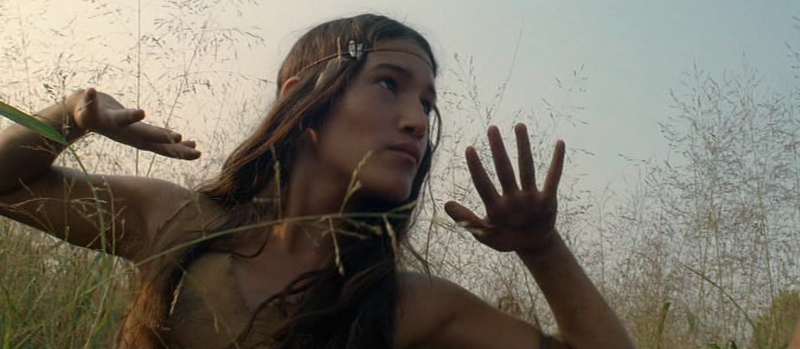
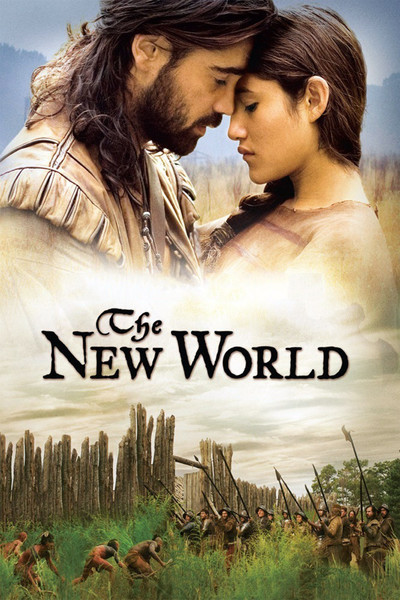
“Who are you whom I so faintly hear? Who urge me ever on? What voice is this that speaks within me?”
Terrance Malick’s The New World is one of the enduring achievements of the aughts. An uncompromising yet lyrical and beautiful investigation of the myth of America’s founding. It is not a conventional film (of course it isn’t, it was directed by Malick). Its plot is only revealed in the broadest of strokes, flavored by interwoven voiceovers from the main characters and scattered footage of nature. The extended cut of the film—clocking in at just under three hours in length—is a meandering masterpiece, unconcerned with the marketability of the final product, focused only on capturing as much wild beauty as possible.
The film is “about” the relationship between the first settlers of Jamestown and the Native Americans (whom the settlers refer to—quite fittingly—as “the Naturals”), but more specifically concerns the relationships of both John Smith and John Rolfe to Pocahontas. But the film is miles from any conventional formula such that it seems inappropriate to trace its plot (plus, most people already know the gist of it). Its three principal actors—Colin Farrell as John Smith, Christian Bale as John Rolfe, and newcomer Q’orianka Kilcher as Pocahontas—inhabit their characters incredibly well; but it is the latter’s performance as the innocent teenager that really anchors the entire film, and it is astounding that she was only fourteen years old when The New World was filmed.
“They are gentle, loving, faithful, lacking in all guile and trickery. The words denoting lying, deceit, greed, envy, slander, and forgiveness have never been heard. They have no jealousy, no sense of possession. Real, what I thought a dream.”
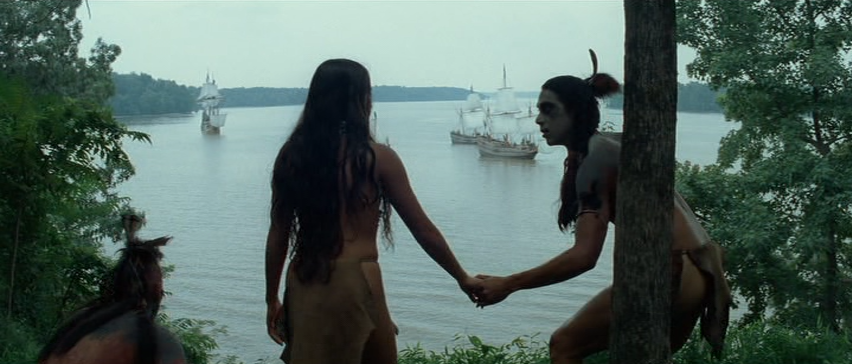
Aside from the first third of the movie, when the question of whether or not the settlers will survive their first winter in the new world is answered, the drama that typically keeps a film rolling is not really there. We follow tangents that do not propel the story, endlessly circle the strange romance between Smith and Pocahontas (who is never explicitly named in the film), and we spend countless moments soaking in the surroundings.
Regarding the latter, there is a richness to this film that comes from shooting on location with a fully realized set. The colonizer’s outpost was constructed in full to allow Malick to shoot from any angle (the director often chooses where to place the camera based on the most intriguing lighting). In typical Malick fashion, he gave the second unit the task of capturing unique footage amidst the complex and sprawling set. Birds chirping, insects and other forest dwellers murmuring, water flowing, plant life swaying in the breeze; they even captured an interaction between Smith and Pocahontas during a real lightning storm. Crucially and subtly (the type of thing that when it is done well you only understand subconsciously), the shots in England are rigid, mirroring the tame and structured landscape.
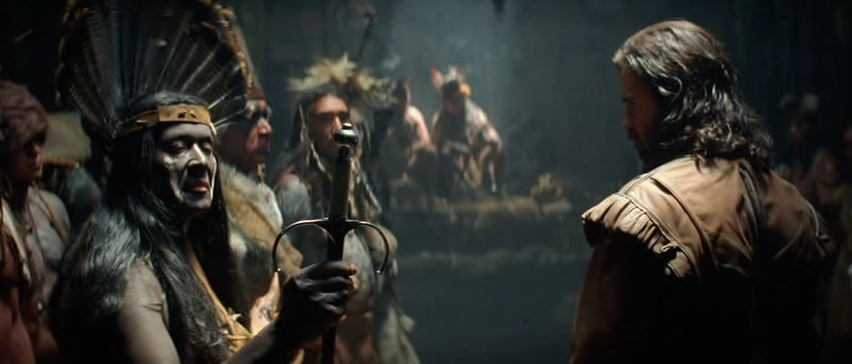
Blair Rudes, a linguistics professor, was tapped to teach the actors how to speak Virginian Algonquin based on a vocabulary list penned by John Smith himself. Initially hired to translate two scenes worth of material into speakable Algonquin, Malick was so enthused by Rudes’s work that he brought the professor on set to allow more of the background cast to speak in the language. The result is so convincing that it almost feels as if Malick was able to locate the nonexistent native speakers that led him to seek out Rudes in the first place.
One of Malick’s tendencies that drives his detractors crazy is his three-fold approach to uncovering his films. Of course, he has a plot, locations, characters, etc. That’s normal. But when he arrives on location, he lets the process unfold where it may, shooting endless amounts of footage of secondary cast members, birds, trees, fire, clouds, sunshine. In some ways, this exploration of the set is similar to Robert Altman’s work on films like McCabe & Mrs. Miller and Nashville, but Altman was more concerned with capturing the random bits of dialogue that in-character actors came up with on-set. It seems silly, but after all the effort of having the actors trained to speak the native language, Malick doesn’t seem concerned at all with capturing many specific lines. This is the third phase of Malick’s filmmaking, which takes place in the editing room. Here, he is moved as much (if not more) by the juxtaposition of imagery and sound than by any compulsion to present a coherent thread of plot. This is where his philosophical and lyrical side comes to the fore, as the reams of footage can be toyed with to find the most evocative imagery. To connect the scenes and give a sense of wholeness, voiceovers are used extensively. The voiceovers keep the narrative moving, and allow for a more poetic linguistic style. Some films can leave a bad taste for overly sophisticated dialogue; but when spoken in monologue form, more considered and artistic language feels natural and (at least in the hands of Malick) elevates the film.
“Dear mother, you fill the land with your beauty. You reach to the end of the world. How shall I seek you? Show me your face. You, a great river that never runs dry.”
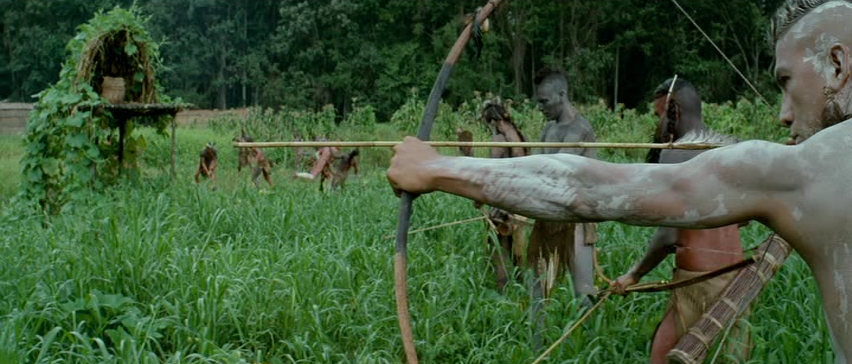
One of my favorite moments in the film is a brief montage of disparate scenes, with James Horner’s score bolstering the voiceover. It begins with Pocahontas running through a field, cuts to Smith participating in a ritual dance, and then to the tribe checking their fishing nets. In the supplements on the Criterion edition of the film, editor Mark Yoshikawa compares the differences between the cuts of the film, and this one in particular stands out. Its resonance requires the lingering elliptical editing. To me, this moment is what makes cinema unique. The combination of music, poetry, moving images, and editing simply can’t be done in any other medium.
“Lawless. Heaven in all things. I was a dead man, now I live. You, my light, my America. Love—shall we deny it when it visits us? Shall we not take what we are given? There is only this, all else is unreal.”
Many critics dislike the use of voiceover. They see it as a last resort of sorts, as if the need for it necessarily means that something was fumbled earlier in the filmmaking process. But in capable hands,1 the use of voiceover can absolutely propel a film to greater heights. Though it may appear in other films, a unique aspect of Malick’s use of voiceover here is that he not only has the voiceover competing with diegetic dialogue at times, he even has separate internal monologues interrupting each other, as if the speakers are exhibiting competing thoughts.
The New World was Malick’s fourth film in what at that point had been a three decade career. Starting with Badlands (1975) and Days of Heaven (1978), Malick then took a twenty year hiatus before helming The Thin Red Line (1998). The New World was his only release in the 2000s, before he began a late career tear of six films in the 2010s, beginning with The Tree of Life (2011). Though Malick’s entire oeuvre stands out from among those of his contemporaries due to his unique style (auteur theory has never been more applicable), The New World has an ancient power to it that allows the film to transcend the realm of cinema.
1. Scorsese is the only other modern director who is on-par with Malick in employing voiceover. Though he uses it differently, the technique is used to great effect in such films as Taxi Driver (1978), GoodFellas (1990), Casino (1995), and The Wolf of Wall Street (2013).
Sources:
Patterson, John. “The New World: a misunderstood masterpiece?”. The Guardian. 10 December 2009.
Boyle, Alan. “How a linguist revived ‘New World’ language”. NBC News. 21 January 2006.
Yoshikawa, Mark. Supplemental interview. The New World, directed by Terrence Malick, 2005. The Criterion Collection.